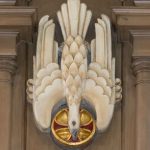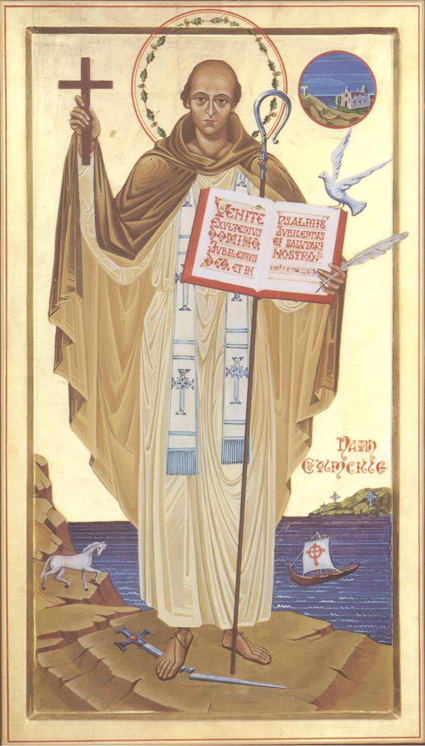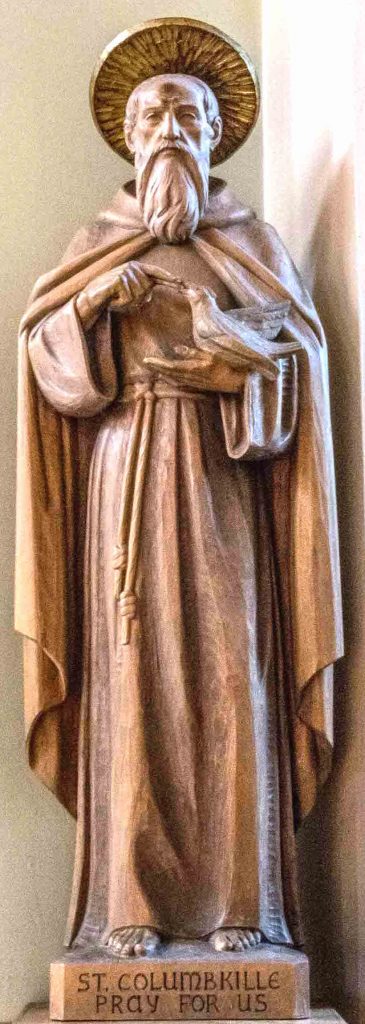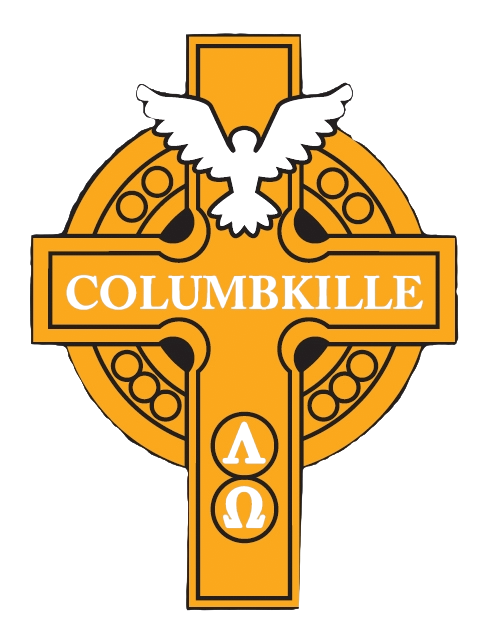
He was a member of the distinguished clan of Neil. His father Felim was a son of Niall of the Nine Hostages and his mother Eithne was a daughter of the Leinster Chief. Columbkille was born at Gartan in the county of Tyrconnel (now Donegal) on the 7th of December in the year 521.

His remarkable display of piety and sacred learning soon earned him many disciples and about the year 550 he founded the great monastery of Dairmagh (now called Durrow) in Co. Leix, and many smaller ones including those at Doire (or Derry) and Sord (or Swords) a few miles north of Dublin. The famous Irish historian Reeves gives names of no less than thirty-seven Churches in Ireland which were founded by Columbkille or in which his memory was specially venerated. An uncle of the Saint had donated Derry – the oak grove – to him and the Round Tower of his monastery stands to the present day, as a monument to his name and memory. Columbkille grew to love this spot most dearly, and long afterwards, during his exile in Iona, he enshrined his love in verse:
My Derry, my derry, my little oak grove,
My Dwelling, my Home, and my own little cell,
May God, the Eternal, in Heaven above
Send woe to Thy foes and defend Thee well.
His love for the poor was such that he made a rule that every day one hundred poor people should be fed at the Monastery gates. One day, two people came to the Monastery – a ne’er-do-well and a beggar, seeking alms. Columbkille gave several coins to the ne’er-do-well while he gave only one to the beggar. This action caused some curiosity amongst the monks who asked for a reason. Columbkille told them to follow the two beggars. They did so and were surprised to find the ne’er-do-well sharing his coins with other people, whilst the beggar was found dead with a large sum of money concealed in his clothes.

On the small island of Iona, about twelve miles from the mainland, Columbkille built the great monastery which was for several centuries the chief seminary of North Scotland, and from which he founded several more monasteries throughout the country. It is said by some authorities that he received the island as a gift from Conall, King of the Dalriadan colony of Caledonia. In his History of Ireland, the Reverend Doctor D’Alton describes Iona as ‘situated but a mile from the great island of Mull, three miles in length and between one and two in breadth, bleak, barren, desolate and lone, bounteous of rock, sparing of fertility, reluctant to yield but the scantiest of crops, its sides worn by the waves, its surfaces swept by the storms – such was Iona in Columbkille’s time, and such is Iona still.’
St. Columbkille’s mode of living was most Spartan and austere. His bed consisted of the bare floor with a stone for his pillow. Despite his long and arduous fasts, his countenance always appeared wonderfully cheerful, and his remarkable mildness and charity towards all won him the respect and love of all who came in contact with him. So revered was he that neither King nor people acted without first consulting him, and when Kind Aedhan or Aidanus succeeded his cousin Conall to the throne of British Scotland in the year 574, he received royal insignia from the hands of St. Columbkille.
As his Churches grew and flourished, fresh aid was required, and the holiest and most learned monks in Ireland offered their services. Amongst others who crossed to Scotland were Ft. Finian, his old master at Moville, who took up residence near Glenfinnan. St Molios carried the Faith to the island of Arran; St. Comgall painted the standard of the cross on the island of Tiree; St. Canice laid the foundations of the Cathedral of St. Andrews in Fifeshire and St. Kentigern did likewise in Glasgow. The Catholic Faith, under Columkille’s leadership, asserted itself as far north as St. Kilda and the Faroe Islands.
It is stated that he wrote some 300 books with hos own hand, two of which, ‘The Book of Durrow’ and the psalter ‘The Catach’ have been preserved to the present day. The psalter, enclosed in a shrine, was originally carried into battle by the O’Donnells as a pledge of victory.
Four years before his death St. Columbkille is said to have been favoured with a vision of angels which left him severely disturbed as these heavenly messengers revealed to him that Almighty God would prolong his earthly exile for yet a further four years, so moved was He by the fervent prayers of the English and Scottish Churches.
Thus, on Pentecost Sunday morning, on the 9th of June in the year 597 – the thirty-second of his priesthood and seventy seventh of his age and exactly thirty-four years after his arrival in Iona – St. Columbkille passed to his eternal reward. His body was buried in Iona, but some centuries later was removed for purposes of safety to Ireland and deposited in the Church of Downpatrick in the one vault with the remains of St. Patrick and St. Bridget.
In Down, three Saints one grave do fill, Patrick, Bridget and Columbkille.
He is honoured in Ireland and Scotland among the principal patrons of both countries and is commemorated in the Roman Martyrology on the 9th of June.
This is the story of the great and holy Saint to whom our Church in Rutherglen is dedicated.
